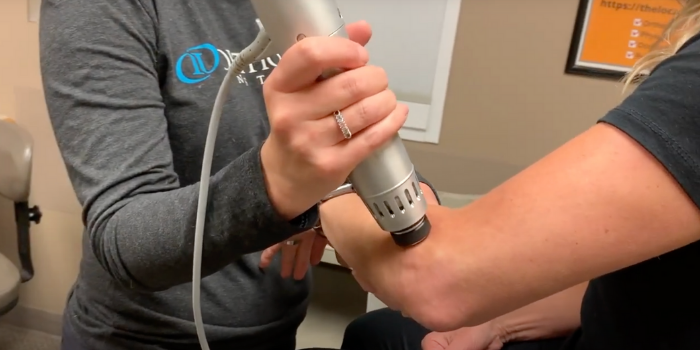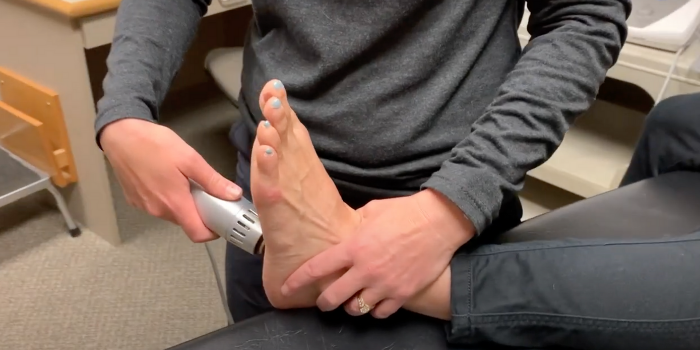Pain in your joints during activities of repetitive motion like golfing, playing tennis, throwing, gardening or even cleaning, is commonly a sign of tendinitis. Tendinitis is inflammation of the tendon, the thick fibrous cords that attach muscle to the bone. The condition causes pain and tenderness around a joint.
Tendinitis occurs when tendons are overused and repeatedly exposed to increased amounts of loading, tension, compression, or friction that are beyond their capacity. When a muscle contracts, the tendon moves the bone. These tendons are susceptible to overuse, leading to tendonitis, micro-tearing, and degeneration over time. A person can experience cumulative cycles of injury, inflammation, and repair, leading to chronic pain and inflammation. Tendinitis may also occur as a result of an acute injury. While tendinitis can occur in any tendon, it's most common around shoulders, elbows, wrists, knees and heels.

The Most Common Tendinitis Injuries
The most common muscle, tendon, ligament, and joint issues, include:
- Plantar fasciitis
- Tennis elbow (lateral epicondylitis)
- Iliotibial band (IT band) syndrome
- Chronic muscle discomfort
- Achilles pain
- Rotator cuff
- Inflammation and tension
- Shin splints
- Lower extremity tendinitis
- Other muscle, tendon, and tissue pain
The Top 3 Signs You Might Have Tendinitis
Signs and symptoms of tendinitis occur where the tendon attaches to the bone. These signs include:
- Pain described as a dull ache
- Tenderness
- Mild swelling
Risk factors for developing tendinitis are increased age, repetitive motion jobs or overhead activity, and activities such as: gardening, raking, cleaning, shoveling, painting, tennis, running, golf, skiing, and throwing.
Treatment for Tendinitis
Treatment for tendinitis varies depending on the severity of the case. The primary goal of treating tendinitis is to minimize pain and inflammation. Most minor cases of tendinitis respond to self-care measures such as rest, activity modification, stretching, and icing. For severe cases of tendinitis, seek medical assistance from your orthopedic surgeon or physical therapist.
To learn more about a multitude of treatment solutions for tendinitis: https://www.mayoclinic.org/diseases-conditions/tendinitis/diagnosis-treatment/drc-20378248
Should I See a Physical Therapist for Treatment of Tendinitis?
For persistent tendinitis that does not respond to rest, ice or at-home treatment, physical therapy may be beneficial. A physical therapist will assess your mobility, strength, and address any movement dysfunctions. They may also guide you through activity modifications, exercise techniques, and evaluate workplace ergonomics.
To learn more about the prevention of musculoskeletal disorders in the workplace:
https://www.osha.gov/ergonomics
Other Ways Physical Therapists Can Treat Tendinitis
In addition to providing a treatment plan, physical therapists may perform treatment to reduce inflammation with treatments such as ultrasounds or iontophoresis. They may also perform Radial Pulse Therapy, instrument-assisted soft tissue mobilization, cross friction massage, and eccentric strengthening programs to stimulate healing.
Using Radial Pulse Therapy (RPT) to Treat Tendinitis
Radial Pulse Therapy (RPT) is one of the best treatment options to treat tendinitis because it is non-invasive and helps quickly reduce pain. RPT uses short, electromagnetic shockwaves delivered from a handheld device. The shockwaves break down scar tissue and cause an inflammatory response. This healing response improves blood circulation, range of motion and reduces pain.
Watch Physical Therapists Kris and Jill Explain and Demonstrate Radial Pulse Therapy
Click Here to Learn More About How Radial Pulse Therapy Can Treat Your Pain.
If you are experiencing pain in your joints during activities of repetitive motion like golfing, playing tennis, throwing, gardening or even cleaning, talk to your physician or physical therapist about the treatment options available for you.



